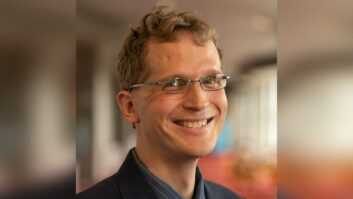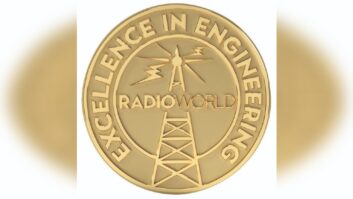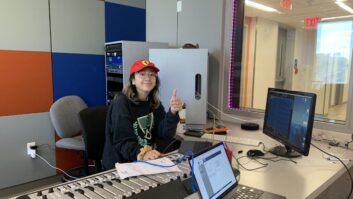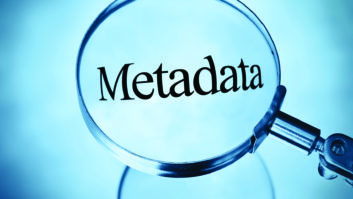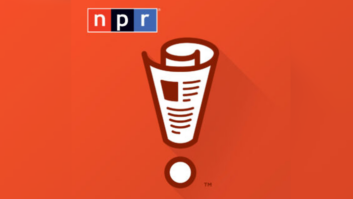GREENVILLE, S.C. — Jerry Massey is disappointed if he doesn’t learn something new every day in his job. He’s pretty sure most broadcast engineers feel the same. The fast-evolving technology of the broadcast industry seems to suit him well.

Massey, director of engineering for Entercom Greenville in South Carolina and corporate regional engineer southeast for Entercom Communications, begins his tenure as president of Society of Broadcast Engineers in October with a plan that focuses on education, retention and recruitment. He will be inducted as president during SBE’s annual membership meeting in Madison, Wis., succeeding Joseph Snelson.
SBE is the professional organization of radio and television engineers and people who work in related fields; it has approximately 5,100 members and more than 100 chapters.
NEED FOR KNOWLEDGE
Massey, 68, noted both the pace of change as well as the expansion in platforms that come under the purview of SBE members.
“Just 10 years ago, about all broadcast engineers had to be concerned with was the studio and transmitter site. Today we have HD signals, streams, a wide variety of IT office, studio and transmitter circuits and programs,” Massey said. “The quest ahead for SBE will be to support our membership through these changes.”
Things were perhaps simpler when Massey began his career in 1973 at WFBC(AM/FM/TV) in Greenville. He remains with the same station group after 42 years.
In hindsight it seems clear he was destined for a career in radio — his first word as a young toddler was “radio,” according to his parents. However, he started out studying chemical engineering major at the University of South Carolina; and his first five years at WFBC were spent on the TV side.
In 1969, during the Vietnam conflict and in his fourth year at USC, Massey was informed he was up to be drafted. Instead, “I chose to join the Air Force and got a tremendous education as a Ground Radio Communications Equipment Repairman. I spent four years in the Strategic Air Command and studied for my FCC First Class License.”
Being settled into one location for so long hasn’t deterred Massey from advancing his training and education — with the help of SBE — which happens to be the focus of his plans as president.
“Going forward, broadcast engineers will have more and more duties added to their charge. While other station, cluster and regional jobs may in time be consolidated or trimmed, it will be the broadcast engineer that will be needed to keep operations of these new technologies functioning.”
Radio and TV face more technology changes that are still being developed. The quest for SBE, he said, will be how to support membership throughout the changes.
“Our main objective will be of course providing the educational webinars and courses that will aid in training members for new technologies,” Massey said. Broadcast engineers need to learn how to manage and support new platforms.”
National Presidents of SBE
Jerry Massey is the 29th president of the Society of Broadcast Engineers. His predecessors, according to www.sbe.org:
Joe Snelson, CPBE, 8-VSB
2013–15
Ralph Hogan, CPBE, DRB, CBNT
2011–13
Vincent Lopez, CEV, CBNT
2009–11
Barry Thomas, CPBE, CBNT
2007–09
Christopher H. Scherer, CPBE, CBNT
2005–07
Raymond C. Benedict, CPBE
2003–05
Troy D. Pennington, CSRE, CBNT
2001–03
James “Andy” Butler, CPBE
1999–01
Edward J. Miller, CPBE
1997–99
Terrence M. Baun, CPBE, CBNT
1995–97
Charles W. Kelly Jr.
1993–95
Richard Farquhar, CPBE
1991–93
Bradley Dick, CPBE
1989–91
Jack McKain, CPBE
1987–89
Richard Rudman, CPBE
1985–87
Roger Johnson, CPBE
1984–85
Doyle Thompson, Sr., CPBE
1983–84
Ron Arendall, CPBE
1981–83
Robert Jones, CSBE
1979–81
James Hurley, CSBE
1978–79
Robert Wehrman
1977–78
Glen Lahman
1975–77
James Wulliman, CPBE
1973–75
Robert Flanders, CPBE
1971–73
Lewis Wetzel, CPBE
1970–71
Al Chismark
1968–70
Charles Hallinan, CPBE
1966–68
John Battison, P.E., CPBE
1965–66
IT-based technologies will continue to dominate broadcast, and the transition to IP technology isn’t slowing, Massey said. “Everything now seems to have some IT base to it. That includes the basic units of consoles, mic processors, editing equipment, EAS systems, STL relays and transmitters.” HD Radio developments, too, are of high interest to SBE membership, Massey said.
For seasoned broadcast engineers, all this means constant study and learning to adapt to those changes, he said.
“The public has more options than ever in obtaining their news and entertainment. For the broadcast industry, this means adapting and providing those new and ever-changing means of access. It’s not the status quo anymore,” Massey said.
The SBE’s Government Relations Committee continues to track the shrinking spectrum for wireless mics and Broadcast Auxiliary Service operations, he said.
“We have filed comments on the FCC’s rulemaking regarding wireless mics. Wireless mics are a staple in the broadcast industry and especially for TV for in studio and remote broadcast, so it’s a big concern.”
In addition, SBE’s large membership of TV engineers has its eyes on ATSC 3 and spectrum repacking.
Those interested in reading SBE’s filings on wireless mics and BAS operations can visit the SBE website at www.sbe.org.
Even the Voltair processor/PPM ratings controversy could present teaching opportunities for SBE. “It may be along the lines of proper placement, alignment, monitoring and problem resolution of encoders and processors that are providing the ratings data to the air signals,” Massey said.
A NOD TO RON
One early career influence was Ron Rackley, principal with duTreil, Lundin and Rackley Inc. Massey credits Rackley for everything he knows about AM directional antennas. When Massey started at WFBC, he was partnered with Rackley, then a student at Bob Jones University in Greenville.
“We worked on the station’s AM directional system. We did field measurement including partial proofs. What a great time to learn from an eventual leading authority on AM directional systems,” Massey said.
Massey today oversees broadcast engineering aspects in Greenville for WFBC(FM), WROQ(FM), WSPA(FM), WTPT(FM) WYRD(FM) and WORD/WYRD(AM). Nielsen ranks the Greenville-Spartanburg metro as market No. 59 for ratings purposes. Its metro 12+ population is just over 924,000, according to Nielsen.
As part of the regional engineering team at Entercom, Massey assists other clusters in the southeast with capitalization and implementation, as well as disaster preparedness and disaster implementation and recovery when necessary. He reports to Entercom’s DOE John Kennedy.
Massey said he is set to lead SBE by example as he steps into the presidency this fall. He was active in establishing SBE Chapter 86 in Greenville and diligent in continuing his education and earning certifications. “I am a Certified Professional Broadcast Engineers (CPBE) with specialties in AM Directional Systems (AMD), Digital Radio Broadcasting (DRB), Digital TV (8-VSB) and a Certified Broadcast Network Technician (CBNT).
”So my message to SBE members is to become certified. If I can do this beginning midlife, you can too. Do it for yourself and do it to show others that you are capable and certified as a broadcast engineer.” He is also a member of the American Radio Relay League and the Blue Ridge Amateur Radio Society.
Massey and his wife Norma have three grown children and live in Simpsonville, S.C.
“I am very thankful to have a wife who is supportive of my busy career. For a broadcast engineer that is a must,” Massey said.






